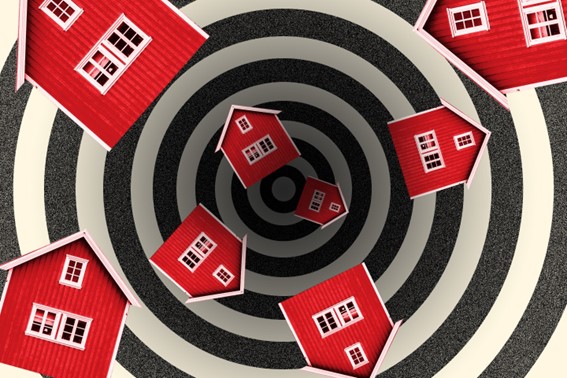
在当前的房地产市场,由于高抵押贷款利率和高房价,不止首次购房人很难找到一套经济实惠的住宅。Zillow周二发布的一份报告称,美国价格昂贵的住宅房价仍在持续上涨,而且中位数房价达到百万美元的城市数量创历史新高。
Zillow的报告显示,美国中位数房价达到或高于100万美元的城市有550个,创历史记录。去年这个数字为491个,增长了12%,而且这些城市的中位数房价同比涨幅为4.6%,这意味着昂贵的住宅仍在继续涨价。
第一基金银行(First Foundation Bank)执行副总裁兼首席运营官克里斯托弗·M·纳吉比对《财富》杂志表示:“对于购房人而言,中位数房价超过百万美元的城市大幅增多,使至少自上世纪80年代以来最严重的房屋可负担性危机更加恶化。这些市场的潜在购房人要面对更高的准入门槛,他们需要支付高额首付和挣得更高收入才能买得起房子。”
百万美元住宅最多的是哪个地区?
迄今为止,加州是“百万美元城市”最集中的地区:该州有210个城市的中位数房价超过100万美元,包括洛杉矶、旧金山、圣何塞、圣巴巴拉和圣地亚哥等。专家们认为,这并不意外,因为加州居民从事高薪工作,同时承受高生活成本。
事实上,加州也是《财富》美国500强公司最集中的州,苹果(Apple)、谷歌(Google)和Meta的总部都位于该州。
蒙特西托苏富比国际(Sotheby’s International)的房屋中介莫林·麦克德莫特对《财富》杂志表示:“硅谷的科技公司也是加州房价上涨的原因之一。加州激烈的房地产市场竞争,再加上低房屋库存,导致房价大幅上涨,这并不意外。”
Coldwell Banker Warburg的房屋中介泰特·凯莉对《财富》杂志表示,由于加州主要城市的“大幅经济增长”,高薪工作的从业者能买得起更昂贵的房子。这只是房地产市场“买房困境”的一部分,即在房价最高的城市,只有富人才能真正买得起房。
凯莉说道:“[这些]公司所在的地区,经济飞速增长。这意味着有大批高薪员工愿意并且能够以更高的价格买房。”
加州房价暴涨给购房人、卖房人和中介带来了全方位的挑战,因为洛杉矶的豪宅税适用于500万美元以上的房地产交易。售价超过500万美元的房屋需额外缴纳4%的税费,而1,000万美元以上的房产需额外缴税5.5%,这些税费通常由卖房人承担。《日落豪宅》(Selling Sunset)节目的明星艾玛·赫南对《财富》杂志表示,豪宅税是“噩梦”,导致房屋中介的业务减少。
然而,不只是加州的房价大幅上涨。有数十个百万美元城市的其他州包括纽约州、新泽西州和佛罗里达州,这同样不令人意外。但纽约州中位数房价达百万美元的城市只有66个,新泽西州有49个,佛罗里达州有32个。这远低于加州的200多个城市。
百万美元城市对房屋可负担性有什么影响?
Zillow的报告显示出潜在购房人想在大城市买房面临很大挑战。对于许多人而言,100万美元的房子,即使只考虑首付金额,都让人觉得遥不可及。10%的首付比例,需要购房人支付100,000美元,这远高于普通美国人的储蓄。事实上,1月的一份GoBankingRates调查显示,接近一半美国人储蓄不足500美元。
由于高抵押贷款利率和房价上涨,即使购买一套入门级住宅,也已经完全超出了许多美国人的承受范围,而且有专家认为这类住房已经不复存在。
麦克德莫特表示:“现在买房越来越难,尤其是经济实惠的住房。至于所谓的‘入门级住宅’,它们在大多数市场已经近乎绝迹。”
而从长远来看,买不起房只会让财务状况更加糟糕。这是因为美国人严重依赖房屋净值来支持个人财务状况,以及未来购买更好或更贵的房子。
纳吉比表示:“这种状况可能让购房人要么扩大寻找范围,选择房价更低的地区,这会增加通勤时间和降低生活质量,要么继续租房,但这会导致更难积累房屋净值。大多数美国人的净资产,主要来自随着时间推移产生的房屋净值。如果他们因为成本问题无法在年轻时买房,这意味着我们创造的平均资产净值更低。”(财富中文网)
翻译:刘进龙
审校:汪皓
Zillow的报告称,美国中位数房价达到百万美元的城市数量创历史新高。PHOTO ILLUSTRATION BY VICTORIA ELLIS/FORTUNE; ORIGINAL PHOTO BY GETTY IMAGES
在当前的房地产市场,由于高抵押贷款利率和高房价,不止首次购房人很难找到一套经济实惠的住宅。Zillow周二发布的一份报告称,美国价格昂贵的住宅房价仍在持续上涨,而且中位数房价达到百万美元的城市数量创历史新高。
Zillow的报告显示,美国中位数房价达到或高于100万美元的城市有550个,创历史记录。去年这个数字为491个,增长了12%,而且这些城市的中位数房价同比涨幅为4.6%,这意味着昂贵的住宅仍在继续涨价。
第一基金银行(First Foundation Bank)执行副总裁兼首席运营官克里斯托弗·M·纳吉比对《财富》杂志表示:“对于购房人而言,中位数房价超过百万美元的城市大幅增多,使至少自上世纪80年代以来最严重的房屋可负担性危机更加恶化。这些市场的潜在购房人要面对更高的准入门槛,他们需要支付高额首付和挣得更高收入才能买得起房子。”
百万美元住宅最多的是哪个地区?
迄今为止,加州是“百万美元城市”最集中的地区:该州有210个城市的中位数房价超过100万美元,包括洛杉矶、旧金山、圣何塞、圣巴巴拉和圣地亚哥等。专家们认为,这并不意外,因为加州居民从事高薪工作,同时承受高生活成本。
事实上,加州也是《财富》美国500强公司最集中的州,苹果(Apple)、谷歌(Google)和Meta的总部都位于该州。
蒙特西托苏富比国际(Sotheby’s International)的房屋中介莫林·麦克德莫特对《财富》杂志表示:“硅谷的科技公司也是加州房价上涨的原因之一。加州激烈的房地产市场竞争,再加上低房屋库存,导致房价大幅上涨,这并不意外。”
Coldwell Banker Warburg的房屋中介泰特·凯莉对《财富》杂志表示,由于加州主要城市的“大幅经济增长”,高薪工作的从业者能买得起更昂贵的房子。这只是房地产市场“买房困境”的一部分,即在房价最高的城市,只有富人才能真正买得起房。
凯莉说道:“[这些]公司所在的地区,经济飞速增长。这意味着有大批高薪员工愿意并且能够以更高的价格买房。”
加州房价暴涨给购房人、卖房人和中介带来了全方位的挑战,因为洛杉矶的豪宅税适用于500万美元以上的房地产交易。售价超过500万美元的房屋需额外缴纳4%的税费,而1,000万美元以上的房产需额外缴税5.5%,这些税费通常由卖房人承担。《日落豪宅》(Selling Sunset)节目的明星艾玛·赫南对《财富》杂志表示,豪宅税是“噩梦”,导致房屋中介的业务减少。
然而,不只是加州的房价大幅上涨。有数十个百万美元城市的其他州包括纽约州、新泽西州和佛罗里达州,这同样不令人意外。但纽约州中位数房价达百万美元的城市只有66个,新泽西州有49个,佛罗里达州有32个。这远低于加州的200多个城市。
百万美元城市对房屋可负担性有什么影响?
Zillow的报告显示出潜在购房人想在大城市买房面临很大挑战。对于许多人而言,100万美元的房子,即使只考虑首付金额,都让人觉得遥不可及。10%的首付比例,需要购房人支付100,000美元,这远高于普通美国人的储蓄。事实上,1月的一份GoBankingRates调查显示,接近一半美国人储蓄不足500美元。
由于高抵押贷款利率和房价上涨,即使购买一套入门级住宅,也已经完全超出了许多美国人的承受范围,而且有专家认为这类住房已经不复存在。
麦克德莫特表示:“现在买房越来越难,尤其是经济实惠的住房。至于所谓的‘入门级住宅’,它们在大多数市场已经近乎绝迹。”
而从长远来看,买不起房只会让财务状况更加糟糕。这是因为美国人严重依赖房屋净值来支持个人财务状况,以及未来购买更好或更贵的房子。
纳吉比表示:“这种状况可能让购房人要么扩大寻找范围,选择房价更低的地区,这会增加通勤时间和降低生活质量,要么继续租房,但这会导致更难积累房屋净值。大多数美国人的净资产,主要来自随着时间推移产生的房屋净值。如果他们因为成本问题无法在年轻时买房,这意味着我们创造的平均资产净值更低。”(财富中文网)
翻译:刘进龙
审校:汪皓
There are more cities with $1 million median-priced homes than ever, according to a Zillow report.
It’s not just first-time homebuyers who are struggling to find an affordable house in today’s market riddled with high mortgage rates and home prices. The most expensive homes in the U.S. just keep getting more expensive—and today there are more cities with $1 million median-priced homes than ever, according to a Zillow report released Tuesday.
There are a record 550 U.S. cities where the typical home value is $1 million or more, according to Zillow. That’s up from 491 last year—a 12% jump—and median year-over-year price growth in these cities is 4.6%, meaning expensive homes are getting more costly.
“For homebuyers, the prevalence of million-dollar cities significantly—greatly—strains what is already the worst housing affordability since at least the 1980s,” Christopher M. Naghibi, executive vice president and chief operating officer at First Foundation Bank, tells Fortune. “Prospective buyers in these markets face higher barriers to entry, needing ridiculously large down payments and higher incomes to afford homes.”
Where are the most million-dollar homes?
By far, California is the state with the most “million-dollar cities”: There are 210 such cities there, including Los Angeles, San Francisco, San Jose, Santa Barbara, and San Diego. That’s not particularly surprising, considering the high-wage jobs and high cost of living that come with being a California resident, experts agree.
Indeed, California is also among the states with the highest density of Fortune 500 companies, including Apple, Google, and Meta.
“Tech companies in Silicon Valley have also contributed to the rising housing prices in California,” Maureen McDermut, a realtor with Sotheby’s International Montecito, tells Fortune. “It isn’t a surprise that housing competition in the state is fierce, which, coupled with low housing inventory, has pushed prices up significantly.”
Due to the “enormous economic growth” in major California cities, people with higher-paying jobs can afford more expensive homes, Tate Kelly, a broker with Coldwell Banker Warburg, tells Fortune. It’s just part of the housing Catch-22, in which only the wealthy can truly afford homes in the most expensive cities.
“There is enormous economic growth where [these] companies are located,” Kelly says. “This means an influx of employees with high-paying jobs willing and able to spend more for their homes.”
The surge in California home prices has been all-around challenging for buyers, sellers, and agents alike due to the mansion tax in Los Angeles, which applies to property sales of at least $5 million. Properties over $5 million incur an additional 4% tax, while properties costing more than $10 million have an extra 5.5% tax—with the tax typically being paid by the seller. Selling Sunset star Emma Hernan told Fortune this tax has been a “nightmare” and has taken business away from agents.
But it’s not just California that’s experiencing major home value growth. Other states that boast dozens of million-dollar cities include New York, New Jersey, and Florida, which is also unsurprising—but New York has just 66 of such cities, New Jersey has 49, and Florida has 32. That’s a far cry from the 200-plus cities in California with $1 million median home prices.
How million-dollar cities affect housing affordability
Zillow’s report shows just how challenging it is for prospective homebuyers hoping to land a house in a major city. For many, a $1 million home is completely out of reach, even if you’re just considering how much a down payment would be. Putting down a mere 10% would set a buyer back $100,000, which is light-years away from what an average American has in savings. Indeed, a GoBankingRates survey from January shows that nearly half of Americans have less than $500 in their savings account.
Even purchasing a starter home is completely out of reach for many Americans, and some experts argue these types of houses don’t even exist anymore, considering how high mortgage rates and home prices have gotten.
“Homes are now harder to come by, especially affordable homes,” McDermut says. “If you look at the concept of ‘starter homes,’ they have become nearly nonexistent in most markets.”
And not being able to afford a home just makes financial matters worse in the long run. That’s because Americans rely so heavily on home equity to bolster their finances and their ability to purchase a better or more expensive home in the future.
“This situation can push buyers to either extend their search to more affordable areas, potentially increasing commute times and reducing quality of life, or to continue renting, which can make it harder to build equity over time,” Naghibi says. “Most Americans build their large portion of their net worth from the equity they build in their homes over time. If they can’t buy homes until later in life due to the cost, that means we are creating a lower average net worth.”






